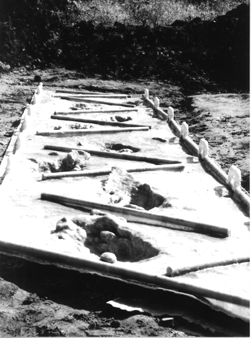The University Record, November 19, 1996
Make tracks for the Exhibit Museum’s new display
By Joanne Nesbit
News and Information Services
 Roughly 10,000 years ago, a mastodon slowly sloshed through shallow water near the shore of a Michigan lake, leaving a trail of footprints in the firm sand of the lakebed. This trackway was discovered near Saline in 1992 by paleontologist Daniel Fisher and a team of assistants. It is believed to be the largest and most complete mastodon trackway ever found.
Roughly 10,000 years ago, a mastodon slowly sloshed through shallow water near the shore of a Michigan lake, leaving a trail of footprints in the firm sand of the lakebed. This trackway was discovered near Saline in 1992 by paleontologist Daniel Fisher and a team of assistants. It is believed to be the largest and most complete mastodon trackway ever found.
Concerned that the trackway was too fragile to excavate and transport to the Exhibit Museum of Natural History, Fisher and a team of volunteers made a 40-foot plastic mold of the prints, reinforced it with fiberglass and a frame of plastic pipe and trucked this cast of the original trackway to the Museum.
Now displayed on a dramatic catwalk extending over the Museum’s Hall of Evolution, the Mastodon Trackway will be opened officially to public viewing at 7:30 p.m. Friday (Nov. 22). At the grand opening ceremony, Fisher will give a slide presentation and Allen Samuels, dean of the School of Art and Design and one of the project’s volunteers, will give his perspective on the operation. The Mastodon Trackway Opening is free, but reservations are required and can be made by calling 763-4190.
Mastodons and mammoths lived in Michigan until their disappearance about 10,000 years ago. Fisher believes this particular trackway of 30 prints, some measuring about 20 inches across, were left by a large male, probably about nine feet tall at the shoulder and weighing approximately six tons. The trackway closely resembles those made by slow-moving modern elephants.
Could there be a mastodon skeleton in your backyard? More than 250 mastodon specimens have been found in the southern half of lower Michigan, and other discoveries may not have been reported. The mastodon tracks on display were found just outside Saline, and other mastodon skeleton pieces have been found even closer to Ann Arbor.
What should you do if you find one? Leave it where you found it and contact U-M’s Museum of Paleontology at 764-0489.
 A membership club for kids ages 4-12, the Exhibit Museum of Archaeology’s Dino Club offers youngsters a chance to have fun while learning more about dinosaurs, wildlife, the night sky and archaeology.
A membership club for kids ages 4-12, the Exhibit Museum of Archaeology’s Dino Club offers youngsters a chance to have fun while learning more about dinosaurs, wildlife, the night sky and archaeology.
For a membership fee of $15, youngsters will receive a membership card, Dino Club stickers, a birthday card, a fun and informative Club newsletter (three times per year), an annual Dino Club party, discounts in the Museum Shop, an invitation to the annual members’ Behind the Scenes tour, and a 20 percent discount on fees for workshops sponsored by the Museum and Planetarium. For a membership application and brochure, contact the Museum at 763-4190.
Rated as one of the top dinosaur exhibits, with one publication giving it a three-bone rating, one of the Exhibit Museum’s most popular attractions is a complete Allosaurus skeleton nearly 20 feet high. Parts of 13 other dinosaurs are at home in the Museum’s Hall of Evolution.
Based on the 1870 gift of 60,000 specimens and artifacts relating to anthropology, botany, geology and zoology that were collected during a five-year expedition around the world by U-M graduate Joseph Beal Steere, the Museum now hosts more than 25,000 school children annually.
Admission to the Museum is free for individuals and families.

